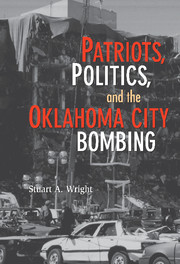Book contents
- Frontmatter
- Contents
- List of Figures and Tables
- Preface and Acknowledgments
- 1 CODICIL TO A PATRIOT PROFILE
- 2 PATRIOTS, POLITICAL PROCESS, AND SOCIAL MOVEMENTS
- 3 THE HISTORICAL CONTEXT OF PATRIOT INSURGENCY
- 4 THE FARM CRISIS, THREAT ATTRIBUTION, AND PATRIOT MOBILIZATION
- 5 STATE MOBILIZATION: BUILDING A TRAJECTORY OF CONTENTION
- 6 THE GUN RIGHTS NETWORK AND NASCENT PATRIOTS: RISE OF A THREAT SPIRAL
- 7 MOVEMENT-STATE ATTRIBUTIONS OF WAR: RUBY RIDGE AND WACO
- 8 PATRIOT INSURGENCY AND THE OKLAHOMA CITY BOMBING
- 9 AFTER OKLAHOMA CITY: PATRIOT DEMOBILIZATION AND DECLINE
- References
- Index
8 - PATRIOT INSURGENCY AND THE OKLAHOMA CITY BOMBING
Published online by Cambridge University Press: 05 June 2012
- Frontmatter
- Contents
- List of Figures and Tables
- Preface and Acknowledgments
- 1 CODICIL TO A PATRIOT PROFILE
- 2 PATRIOTS, POLITICAL PROCESS, AND SOCIAL MOVEMENTS
- 3 THE HISTORICAL CONTEXT OF PATRIOT INSURGENCY
- 4 THE FARM CRISIS, THREAT ATTRIBUTION, AND PATRIOT MOBILIZATION
- 5 STATE MOBILIZATION: BUILDING A TRAJECTORY OF CONTENTION
- 6 THE GUN RIGHTS NETWORK AND NASCENT PATRIOTS: RISE OF A THREAT SPIRAL
- 7 MOVEMENT-STATE ATTRIBUTIONS OF WAR: RUBY RIDGE AND WACO
- 8 PATRIOT INSURGENCY AND THE OKLAHOMA CITY BOMBING
- 9 AFTER OKLAHOMA CITY: PATRIOT DEMOBILIZATION AND DECLINE
- References
- Index
Summary
In the recursive dynamic of state-movement attributions of war, the 1993 Brady Bill and the 1994 Crime Control Bill were perceived by Patriot and gun rights groups as the final broadside. The two controversial gun control bills followed a torrent of paramilitary gun raids, highlighted by the deadly sieges at Ruby Ridge and Waco. The trajectory of contention can be understood as a derivative of this escalating threat attribution of warfare between the state and challenging groups. What doubts many movement sympathizers and marginal free riders may have had about Patriot claims of state disarmament were quickly dispelled by the new gun control legislation. Patriot leaders construed the new legislation as an unabashed push toward a gun ban and drew comparisons to the fictional Cohen Act described in The Turner Diaries. Even as the Cohen Act and the “Gun Raids” triggered the insurgency of Earl Turner and the violent underground insurgency in the Diaries, the threat attributed to the Brady and Crime Control Bills in the wake of disturbingly similar gun raids by state PPUs, capped by Ruby Ridge and Waco, galvanized the Patriot movement and incited acts of insurgency.
Making effective use of the strategy developed at the Estes Park meeting in 1992, the Patriot movement broadened its base among a wide range of far-right groups as leaders worked to both facilitate diffusion along existing lines of communication and broker new social sites.
- Type
- Chapter
- Information
- Patriots, Politics, and the Oklahoma City Bombing , pp. 166 - 193Publisher: Cambridge University PressPrint publication year: 2007
- 2
- Cited by



